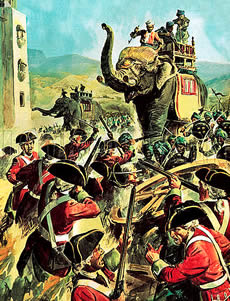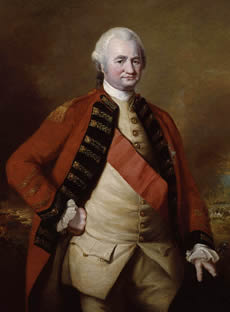World History
Robert Clive went to India as a clerk of the British East India Company. Through daring and ability he was instrumental in defeating the French and their Indian allies. He consolidated British power in Bengal in the Battle of Plassey in 1757 and twice served as governor of Bengal.
The English (later British) East India Company was established in 1600, the French East India Company in 1664. The goal of both was to establish trading stations in India, and neither harbored territorial goals until after Emperor Aurangzeb’s death in 1707, when the Mughal Empire began to disintegrate.
The French governor-general at Pondicherry (the leading French trading station in India) Joseph Dupleix (1697–1764) was first to make alliances with native rulers and train Indian soldiers (called sepoys) under French command and with European firearms. Through these means Dupleix gained land and influence for France. Significantly Dupleix’s forces captured the British Fort St. George (Madras) in 1746 and took Robert Clive, a clerk recently arrived from England, prisoner.
Clive escaped, took a commission in the British East India Company’s army, and in a brilliant maneuver, defeated the forces of the ruler of Hyderabad, France’s major ally in the Deccan, and captured an important port called Arcot against great odds. As a result Dupleix was recalled to France in disgrace. Clive then took a page from Dupleix’s book and began to train sepoys.
In 1756, the new Mughal governor of Bengal, Siraj-ud-Daula, sent an army against the British trading settlement at Calcutta. Most of the 146 English men and women who could not flee died in a dungeon in which they were imprisoned. This episode, called “The Black Hole of Calcutta,†gave Clive the pretext he needed for expanding British power in Bengal.
He recaptured Calcutta and with a small force of 1,000 Europeans and 2,000 sepoys and eight pieces of artillery decisively defeated Siraj-ud-Daula’s 35,000 infantry, 15,000 cavalry, and 50 cannons manned by Frenchmen, with only 22 Europeans killed and 49 wounded. This was the famous Battle of Plassey, after which Clive made a pro-British Indian governor of Bengal under his tutelage until he returned to England in 1760.
 In recognition the British government ennobled him as Baron Clive of Plassey. Britain and France were once again enemies between 1756 and 1763 during the Seven Years’ War when Britain’s superior navy blocked French reinforcements from reaching India. In 1761, Britain captured Pondicherry, finally ending French imperial aspiration in India.
In recognition the British government ennobled him as Baron Clive of Plassey. Britain and France were once again enemies between 1756 and 1763 during the Seven Years’ War when Britain’s superior navy blocked French reinforcements from reaching India. In 1761, Britain captured Pondicherry, finally ending French imperial aspiration in India.
Clive returned to India in 1765 as governor of Bengal to settle problems that had arisen since his departure. He made an agreement with the now very weak Mughal emperor whereby the British East India Company was made revenue administrator for the provinces of Bihar and Bengal, making it de facto territorial ruler of this huge Indian territory.
After organizing the administration of Bengal, Clive returned to Britain in 1767. He faced a parliamentary inquiry instigated by his enemies for corruption while in India but was exonerated. Depressed by the charges, he committed suicide in 1774.
Clive’s was a remarkable career of empire building. He played a crucial role in the elimination of France from India and set the stage for the British Empire on the subcontinent. For this reason he is called Clive of India.
- French East India Company
The French East India Company was one of several companies created to promote Western European commercial interests in Asia, particularly in India, beginning in the 17th century. Lured by Spanish and Portuguese traders’ tales of lucrative spice...
- History Of Pakistan
History of Pakistan. This site is a brief essay on the history of the Asian nation of Pakistan. Unfortunately, it is mostly a modern history as it primarily focuses on the 20th Century. Wikipedia notes, "The Islamic Republic of Pakistan (Urdu: ??????...
- History Of Bangladesh
History of Bangladesh. This essay presents the history of Bangladesh in a short and readable format. From the site: Bengal was absorbed into the Mughul Empire in the 16th century, and Dhaka, the seat of a nawab (the representative of the emperor),...
- Teaching About India
Teaching about India. This essay has ideas for teaching about India. This includes dealing with the history of India. From the site: India, a significant area of Asia in the past, is a very important part of today's world. Therefore, the peoples...
- East India Company: Qatar Digital Archives
Studying exploration? Here's a great summary of the East India Company. Want to learn about slavery in Arabia in the 19th century? Here are documents that outline the slavery that the British encountered. And its different from the slavery the...
World History
Robert Clive - British Empire Builder
 |
| Robert Clive - British Empire Builder |
The English (later British) East India Company was established in 1600, the French East India Company in 1664. The goal of both was to establish trading stations in India, and neither harbored territorial goals until after Emperor Aurangzeb’s death in 1707, when the Mughal Empire began to disintegrate.
The French governor-general at Pondicherry (the leading French trading station in India) Joseph Dupleix (1697–1764) was first to make alliances with native rulers and train Indian soldiers (called sepoys) under French command and with European firearms. Through these means Dupleix gained land and influence for France. Significantly Dupleix’s forces captured the British Fort St. George (Madras) in 1746 and took Robert Clive, a clerk recently arrived from England, prisoner.
Clive escaped, took a commission in the British East India Company’s army, and in a brilliant maneuver, defeated the forces of the ruler of Hyderabad, France’s major ally in the Deccan, and captured an important port called Arcot against great odds. As a result Dupleix was recalled to France in disgrace. Clive then took a page from Dupleix’s book and began to train sepoys.
  |   |
In 1756, the new Mughal governor of Bengal, Siraj-ud-Daula, sent an army against the British trading settlement at Calcutta. Most of the 146 English men and women who could not flee died in a dungeon in which they were imprisoned. This episode, called “The Black Hole of Calcutta,†gave Clive the pretext he needed for expanding British power in Bengal.
He recaptured Calcutta and with a small force of 1,000 Europeans and 2,000 sepoys and eight pieces of artillery decisively defeated Siraj-ud-Daula’s 35,000 infantry, 15,000 cavalry, and 50 cannons manned by Frenchmen, with only 22 Europeans killed and 49 wounded. This was the famous Battle of Plassey, after which Clive made a pro-British Indian governor of Bengal under his tutelage until he returned to England in 1760.

Clive returned to India in 1765 as governor of Bengal to settle problems that had arisen since his departure. He made an agreement with the now very weak Mughal emperor whereby the British East India Company was made revenue administrator for the provinces of Bihar and Bengal, making it de facto territorial ruler of this huge Indian territory.
After organizing the administration of Bengal, Clive returned to Britain in 1767. He faced a parliamentary inquiry instigated by his enemies for corruption while in India but was exonerated. Depressed by the charges, he committed suicide in 1774.
Clive’s was a remarkable career of empire building. He played a crucial role in the elimination of France from India and set the stage for the British Empire on the subcontinent. For this reason he is called Clive of India.
- French East India Company
The French East India Company was one of several companies created to promote Western European commercial interests in Asia, particularly in India, beginning in the 17th century. Lured by Spanish and Portuguese traders’ tales of lucrative spice...
- History Of Pakistan
History of Pakistan. This site is a brief essay on the history of the Asian nation of Pakistan. Unfortunately, it is mostly a modern history as it primarily focuses on the 20th Century. Wikipedia notes, "The Islamic Republic of Pakistan (Urdu: ??????...
- History Of Bangladesh
History of Bangladesh. This essay presents the history of Bangladesh in a short and readable format. From the site: Bengal was absorbed into the Mughul Empire in the 16th century, and Dhaka, the seat of a nawab (the representative of the emperor),...
- Teaching About India
Teaching about India. This essay has ideas for teaching about India. This includes dealing with the history of India. From the site: India, a significant area of Asia in the past, is a very important part of today's world. Therefore, the peoples...
- East India Company: Qatar Digital Archives
Studying exploration? Here's a great summary of the East India Company. Want to learn about slavery in Arabia in the 19th century? Here are documents that outline the slavery that the British encountered. And its different from the slavery the...
